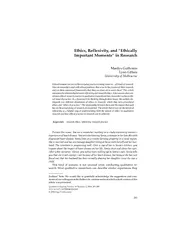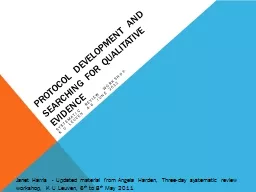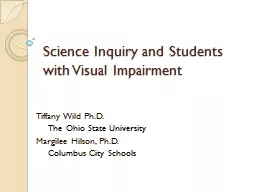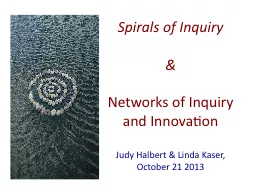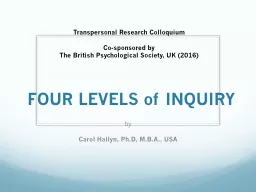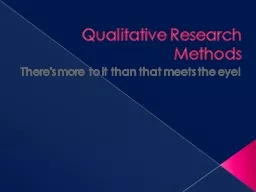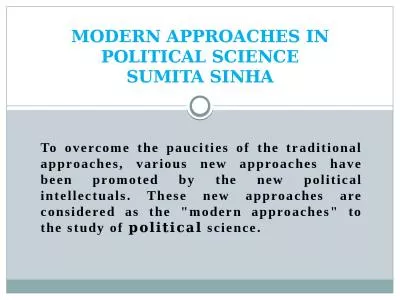PPT-Approaches to Qualitative Inquiry
Author : studyne | Published Date : 2020-06-16
Narrative phenomenological ethnographic case study Action research grounded theory Research paradigms Qualitative researchers generally see human behavior as something
Presentation Embed Code
Download Presentation
Download Presentation The PPT/PDF document "Approaches to Qualitative Inquiry" is the property of its rightful owner. Permission is granted to download and print the materials on this website for personal, non-commercial use only, and to display it on your personal computer provided you do not modify the materials and that you retain all copyright notices contained in the materials. By downloading content from our website, you accept the terms of this agreement.
Approaches to Qualitative Inquiry: Transcript
Narrative phenomenological ethnographic case study Action research grounded theory Research paradigms Qualitative researchers generally see human behavior as something that is influenced by both internal and external factors Thus human behavior is variable and can change from person to person time to time and situation to situation. We recommend that you consult the suggested readings at the end of the module for more indepth treatment of the foundations of qualitative research This module covers the following topics Introduction to Qualitative Research Comparing Qualitative 11771077800403262360 ARTICLE QUALITATIVE INQUIRY April 2004 Guillemin Gillam ETHICALLY IMPORTANT MOMENTS Ethics Reflexivity and Ethically Important Moments in Research Marilys Guillemin Lynn Gillam University o Life, Strength and Hope. Presented by: Rick Krivanka . Diocese of Scranton February 2013 . Three Pillars of a . New Movement. A Starting Context. An essential role of . leadership: . Creating the culture. Systematic review workshop. K U Leuven 4-6 June 2012. Janet Harris - Updated material from Angela . Harden, Three-day systematic review workshop, K U Leuven, 6. th. to 8. th. May 2011. Why develop a protocol?. Tiffany Wild Ph.D.. The Ohio . S. tate University. Margilee Hilson, Ph.D.. Columbus City Schools. What is Inquiry?. Questions. P. riority . to . evidence . Explanations to questions are formed from evidence. & . Networks of Inquiry and Innovation. Judy Halbert & Linda . Kaser. , . October 21 2013. Questions to explore. What are the goals of the networks of inquiry and innovation?. What are we learning?. Qua. n. titative and qualitative data. Questionnaires can gather both sets of data, as can interviews.. This is called a mixed method. Some research only used one type of data. Qua. n. titative: Involve . by. . Carol . Hallyn. , . Ph.D. , . M.B.A., . USA. Transpersonal Research Colloquium. . Co-sponsored by. The British Psychological Society, UK (2016). . . . . PURPOSE. . To heighten awareness . What is an inquiry?. “Inquiry is an approach to learning whereby students find and use . a variety of sources . of information and ideas to . increase their understanding. of a problem, topic or issue of importance. It requires more than simply answering questions or getting a right answer. It espouses . Empirical Qualitative Research. Approaches to . Empirical Qualitative Research. Natural . observation. Participant . observation. In . person interviews . (in-depth and focused). Group . interviews. Empirical Qualitative Research. Module 14. Overview. Qualitative Research. Broad view of features. Many traditions. Contrasts with quantitative research. Qualtitative. method roadmap. Data collection methods. Standards of evaluation. There. ’. s more to it than that meets the eye!. Definition:. Definition:. Qualitative research is used to gain insight into people’s attitudes, behavior, value systems, concerns, motivations, aspirations, culture or life styles etc.. Gay, Mills, and Airasian. State the definition and purpose of qualitative research. . 1.1 Define . qualitative research. . . 1.2 Describe the purpose of qualitative research. . 1.3 Identify four unique characteristics of qualitative research.. political. science.. MODERN APPROACHES IN . POLITICAL . SCIENCE. SUMITA SINHA. CHARACTERISTICS OF MODERN APPROACHES. These approaches draw conclusion from empirical data.. These approaches go beyond the study of political structures and its historical analysis. .
Download Document
Here is the link to download the presentation.
"Approaches to Qualitative Inquiry"The content belongs to its owner. You may download and print it for personal use, without modification, and keep all copyright notices. By downloading, you agree to these terms.
Related Documents


